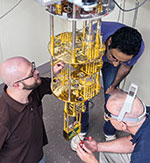
When all is said and done, our lights will be just as bright and our refrigerators just as cold.
But very soon the ampere – the SI base unit of electrical current – will take on an entirely new identity, and scientists at NIST (the National Institute of Standards and Technology in the USA) are at work on an innovative, quantum-based measurement system that will be consistent with the impending change.
In 2018, the base units of the International System of Units (SI) are scheduled to be redefined in terms of physical constants, with major changes in the kilogram, ampere, kelvin and mole. It won’t be a minute too soon. The ampere (A) has long been a sort of metrological embarrassment. For one thing, its 70-year-old formal definition, phrased as a hypothetical, cannot be physically realised as written:
The ampere is that constant current which, if maintained in two straight parallel conductors of infinite length, of negligible circular cross-section, and placed 1 metre apart in vacuum, would produce between these conductors a force equal to 2 x 10–7 newton per metre of length.
For another, the amp’s status as a base unit is problematic. It is the only electrical unit among the seven SI base units, so you might logically expect that all other electrical units, including the volt and the ohm, will be derived from it. But that’s not the case. In fact, the only practical way to realise the ampere to a suitable accuracy now is by measuring the nominally ‘derived’ volt and ohm using quantum electrical standards and then calculating the ampere from those values.
In 2018, however, the ampere is slated to be redefined in terms of a fundamental invariant of nature: the elementary electrical charge (e). Direct ampere metrology will thus become a matter of counting the transit of individual electrons over time.
One promising way to do so is with a nanoscale technique called single-electron transport (SET) pumping. Specially adapted at NIST for this application, it involves applying a gate voltage that prompts one electron from a source to tunnel across a high-resistance junction barrier and onto an ‘island’ made from a microscopic quantum dot.
The presence of this single extra electron on the dot electrically blocks any other electron from tunnelling across until a gate voltage induces the first electron to move off the island, through another barrier, and into a drain. When the voltage returns to its initial value, another electron is allowed to tunnel onto the island; repeating this cycle generates a steady, measurable current of single electrons.
There can be multiple islands in a very small space. The distance from source to drain is a few micrometres, and the electron channels are a few tens of nanometres wide and 200 nm to 300 nm long. And the energies involved are so tiny that that device has to be cooled to about 10 millikelvin in order to control and detect them reliably.

Conventional, metallic SET devices, says NIST quantum-ampere project member Michael Stewart, can move and count single electrons with an uncertainty of a few parts in 108 – in the uncertainty range of other electrical units – at a rate of tens of millions of cycles per second. “But the current in a single SET pump is on the order of picoamperes [10-12 A],” he says, “and that’s many orders of magnitude too low to serve as a practical standard.”
So Stewart, colleague Neil Zimmerman, and co-workers are experimenting with ways to produce a current 10 000 times larger. By using all-silicon components instead of conventional metal/oxide materials, they believe that they will be able to increase the frequency at which the pump can be switched into the gigahertz range.
By running 100 pumps in parallel and combining their output, the researchers anticipate getting to a current of about 10 nanoamperes. Another innovation under development may allow them to reach a microampere, in the range that is needed to develop a working current standard. “At present, we are testing three device configurations of different complexity,” Stewart says, “and we’re trying to balance the fabrication difficulties with how accurate they can be.”

In addition to its use as an electrical current standard, a low-uncertainty, high-throughput SET pump would have two other significant benefits. The first is that it might be combined with ultra-miniature quantum standards for voltage or resistance into a single, quantum-based measurement suite that could be delivered to factory floors and laboratories. The overall effort to provide such standards for all the SI base units is known as ‘NIST-on-a-Chip,’ and is an ongoing priority of NIST’s Physical Measurement Laboratory.
The other advantage is that an SET pump could be used in conjunction with voltage and resistance standards to test Ohm’s Law. Dating from the 1820s, it states that the amount of current (I) in a conductor is equal to the voltage (V) divided by the resistance (R): I = V/R. This relationship has been the basis for countless millions of electrical devices over the past two centuries. But metrologists are interested in testing Ohm’s Law with components which rely on fundamental constants. An SET pump could provide an all-quantum mechanical environment for doing so.
In a separate effort, scientists at NIST are experimenting with an alternative technology that determines current by measuring the quantum ‘phase-slips’ they engender while travelling through a very narrow superconducting wire.
For more information visit www.nist.gov

© Technews Publishing (Pty) Ltd | All Rights Reserved